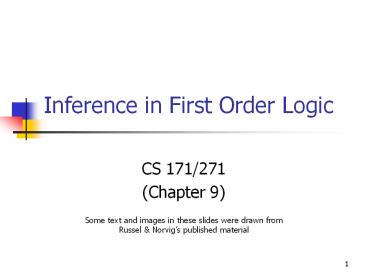Inference in First Order Logic - PowerPoint PPT Presentation
1 / 20
Title:
Inference in First Order Logic
Description:
SUBST({v/k}, a) yet in the knowledge base. 10. Back to Propositionalization ... Carry out reduction and inference process for depth 1, then 2, then 3, ... – PowerPoint PPT presentation
Number of Views:101
Avg rating:3.0/5.0
Title: Inference in First Order Logic
1
Inference in First Order Logic
- CS 171/271
- (Chapter 9)
- Some text and images in these slides were drawn
fromRussel Norvigs published material
2
Inference Algorithms
- Reduction to Propositional Inference
- Lifting and Unification
- Chaining
- Resolution
3
Propositionalization
- Strategy convert KB to propositional logic and
then use PL inference - Ground atomic sentences become propositional
symbols - What about the quantifiers?
4
Example
- KB in FOL
- ?x King(x) ? Greedy(x) ? Evil(x)
- King(John)
- Greedy(John)
- Brother(Richard,John)
- The last 3 sentences can be symbols in PL
- Apply Universal Instantiation to the first
sentence
5
Universal Instantiation
- UI says that from a universally quantified
sentence, we can infer any sentence obtained by
substituting a ground term for the variable - Back to Example
- From ?x King(x) ? Greedy(x) ? Evil(x)
- To
- King(John) ? Greedy(John) ? Evil(John)
- King(Richard) ? Greedy(Richard) ? Evil(Richard)
6
Issue with UI
- Ground terms all symbols that refer to objects
as well as function applications (recall that
function applications return objects) - For example, suppose Father is a function
- Father(John) and Father(Richard) are also
objects/ground terms - But so are Father(Father(John)) and
Father(Father(Father(John))) - Infinitely many ground terms/instantiations
7
Existential Instantiation
- Whenever there is a sentence, ?x P, introduce a
new object symbol called the skolem constant and
then add the unquantified sentence P,
substituting the variable with that constant - Example
- From ?x Crown(x) ? OnHead(x, John)
- To Crown(Cnew) ? OnHead(Cnew, John)
8
Substitution
- UI and EI apply substitutions
- A substitution is represented by a variable v and
a ground term g v/g - Can have sets of these pairs if there are more
variables involved - Let ? be a sentence (possibly containing v)
- SUBST( v/g, ? ) stands for the sentence that
applies the substitution to ?
9
UI and EI Defined
- UI ?v a ___ for any ground term g
SUBST(v/g, a) - EI ?v a ___ for some constant symbol k
not SUBST(v/k, a) yet in the knowledge base
10
Back to Propositionalization
- Given a KB in FOL, convert KB to PL by
- applying UI and EI to quantified sentences
- converting atomic sentences to symbols
- If there are no functions (Datalog KB), UI
application does not result in infinitely many
sentences - Regular PL Inference can now be carried out
without problems - What if there are functions?
11
Dealing with Infinitely Many Ground Terms
- Can set a depth-limit for ground terms
- Depth specifies levels of function nesting
allowed - Carry out reduction and inference process for
depth 1, then 2, then 3, - Stop when entailment can be concluded
- This works if there is such a proof, but goes
into an endless loop if there is not - The strategy is complete
- The entailment problem in this sense is
semidecidable
12
Inefficiencies in Propositionalization
- An inordinate number of irrelevant sentences may
be generated, resulting from UI - This motivates generating only those sentences
that are important in entailment
13
Example
- Suppose KB contains
- ?x King(x) ? Greedy(x) ? Evil(x)
- ?y Greedy(y)
- King(John)
- Suppose we want to conclude Evil(John)
- Because of the existence of objects other than
John (such as Richard) and the existence of
functions, UI will generate many sentences
14
Example, continued
- It is sufficient to generate
- King(John) ? Greedy(John) ? Evil(John)
- Greedy(John)
- Which is just
- SUBST( x/John, King(x) ? Greedy(x) ? Evil(x) )
- SUBST( y/John, Greedy(y) )
- Applying the substitution matches the
- Premises King(x) ? Greedy(x)
- With other sentences in the KBGreedy(y),
King(John)
15
Lifted Modus Ponens
- Lifting Raising propositional inference rules to
first order logic - Example Generalized Modus Ponens
- If there is a substitution ?, such thatSUBST(?,
pi) SUBST(?, pi) for all i, then - p1', p2', , pn, ( p1 ? p2 ? ? pn ? q)
- ________________________________________________
_______________________________ - SUBST(?,q)
- In our example, ? x/John, y/John
16
Unification
- Process that makes logical expressions identical
- Goal match the premises of implications so that
conclusions can be derived - UNIFY algorithm takes two sentences and returns a
unifier (substitution) if it exists
17
Unification Algorithm
18
Unification Algorithm
19
About UNIFY
- UNIFY returns a Most General Unifier (MGU)
- There are efficiency issues withOCCUR-CHECK
function - May need to standardize apart rename variables
to avoid name clashes - Unification is a key component of all first-order
algorithms
20
Whats Next?
- Forward and backward chaining algorithms for FOL
that use unification - Resolution-based theorem proving systems































